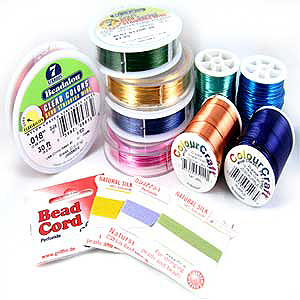As a beader, how many different types of stringing materials have you used?
If you already have plenty of jewelry projects in mind, knowing what type of stringing materials could get a little confusing as there are plenty to choose from. In this article, we’ll give you the most common stringing materials and where you could use them for.
- Memory wire. Strong and can retain the shape of a coil, memory wire is good for wrapping around bracelets. Since it can stretch really long, it will surely fit to wrists of any size. The great thing about this wire is it can be utilized for chokers too. When finishing off the ends, use round nose pliers to make a loop and tie a beaded charm for extra pizzazz.
- Elastic wire. Ideal for creating stretch bracelets and necklaces, an elastic wire is very easy to use. If you’re done with stringing beads, pull the elastic tight and knot the ends together. Cut off any excess and the knot will be hidden underneath the beads. Elastic wires come in a variety of colors and the thickness is an essential material to use for beginners. If you’re into creating jewelry for kids, then elastic wire is the one for you.
- Flexible beading wire. When stringing beads and necklaces, flexible beading wires like Soft Flex®, Beadalon and Tigertail are the most noteworthy choices. They are very flexible like a thread but are a bit stronger. They are mainly useful when utilizing beads with sharp edges as they won’t be able to cut through the material. Sizes usually range from .012 to .024 with the latter as the thickest.
- Coated Copper Wire. A bit rigid compared to flexible beading wires, this wire can be shaped easily with pliers. Copper coated wire comes in a very thin 34 gauge, which is good for wire knitting, and an 18 gauge, which is used for experimenting with heavy jewelry.
- Leather cord. Genuine leather cord remains a popular choice for beaders when stringing large holes. It definitely looks stunning on its own as a necklace when you attach a simple pendant. This material is often used in modern casual jewelry or bohemian style.
- Faux leather cord. A sturdy material that looks almost identical to leather cord, faux leather cord is perfect for jewelry projects as it still functions even if it gets wet. However, it doesn’t work well in extremely low temperatures. Since a faux leather cord is machine-made, it’s more uniform in size and color than genuine leather cord.
There are plenty of different types of stringing materials on the market but to decide which one to use, you need to think of what you’re stringing. With plenty of jewelry styles, there’s no type of cord or string that can do it all.
This is just part one of our list of stringing materials. Make sure to stay tuned for part two!

